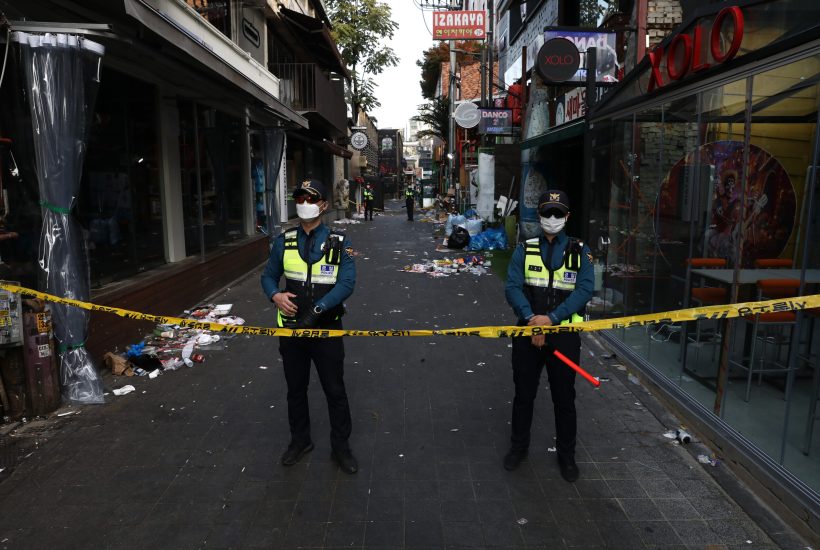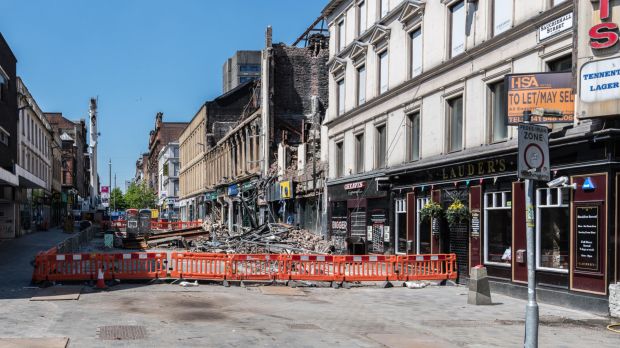At least 151 people were crushed or trampled to death in a narrow alley in the South Korean capital Seoul last night. That figure – which is expected to rise – makes it one of the worst peacetime disasters in the country’s history. President Yoon Suk-yeol has declared a national period of mourning. Both Rishi Sunak and Joe Biden have sent messages of sympathy.
The victims, many of whom were young women, were celebrating Halloween in the Itaewon entertainment district of the South Korean capital. Details of exactly what happened are sketchy, but it seems that a huge mass of people poured in to one of the area’s narrow alleyways, where panic provoked a stampede which led to those at one end of the street falling over. First came a cascade of partygoers, then a disaster.
It is likely that the immediate focus for the authorities will be on crowd management issues and questions such as how such a mass of people was allowed to get dangerously out of control – and why emergency services struggled to reach those in need. There will be intense scrutiny of the layout of the Itaewon district and inquiries as to whether bars and clubs in the areas were following safety regulations. Expect measures such as crowd limits to be introduced and crush barriers erected in the near future.
All of this is necessary, of course, but there is a danger that one hugely important consideration surrounding the tragedy will be neglected or ignored, and a vital, but uncomfortable question will not be asked: why did such a huge crowd – estimated by the Korea Herald to be 100,000-strong – gather for such a relatively innocuous event as Halloween (which has almost no connection with Korean culture) in the first place?
The reasons for the popularity of Halloween in South Korea, and indeed Japan, are numerous. One is simply business: the event has become a mainstay of marketing since Disney’s first Halloween event in Tokyo in 2000. Seoul’s Everland followed suit and now Halloween-themed attractions appear and events are held from early September in South Korea and Japan with bars, clubs and restaurants joining in as profitably as they can. Halloween events indulge the Korean and Japanese love of cosplay (dressing in elaborate costumes), and the ghoulish masquerade provides perfect Instagrammable opportunities for the iPhone addicted youth.
Halloween events are also a conspicuously international: it has become the custom for locals and foreigners to mingle far more than they usually would. Traditional festivals in Korea and Japan celebrate ancient, and often obscure, indigenous culture that can seem baffling and remote to young natives unacquainted with their country’s folklore. And Halloween is less controversial than Christmas in that there is no religious content. At least 19 of those who died in Seoul last night were foreign nationals.
Halloween has grown in popularity in South Korea – but it doesn’t explain why last night’s crowd was so enormous. Witnesses to the tragedy have stated that numbers were far in excess of pre-pandemic festivals. ‘It was at least ten times more crowded than usual,’ 21-year-old Moon Ju-young told Reuters.
South Korea was far from the strictest country when it came to enforced restrictions. However, all large-scale events were cancelled: this was the first big opportunity in three years for the youth of Seoul to get out into the streets and party. Perhaps, then, the authorities should have anticipated their excitement and prepared for larger crowds than usual, eager to celebrate with their peers after a period of enforced isolation.
Seoul’s Halloween event was not a protest, as the Black Lives Matter demonstrations in London during lockdown were (which also attracted larger-than-expected crowds), and there are no reports of criminality or anti-social behaviour connected to the tragedy. On the evidence we have so far, the whole thing looks like a horrendous accident. But it is surely not frivolous, or disrespectful, to speculate that the disaster would not have occurred had the crowd been of a normal size for this kind of event.
Since other obvious explanations for the inflated size of the crowd this year are lacking, it should be acknowledged that the tragedy provokes disturbing questions about the true cost of lockdown – and of suppressing for extended periods of time a human desire to congregate and have fun.
Got something to add? Join the discussion and comment below.
Get 10 issues for just $10
Subscribe to The Spectator Australia today for the next 10 magazine issues, plus full online access, for just $10.



















Comments
Don't miss out
Join the conversation with other Spectator Australia readers. Subscribe to leave a comment.
SUBSCRIBEAlready a subscriber? Log in